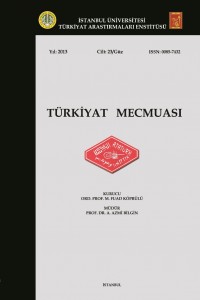Abstract
Upon the revolt of Mehmet Ali Pasha, the governor of the Egypt, and its threatening reverberation in Istanbul forced the Ottoman Empire to ask for help from the European states, however, since this appeal was rejected by these states, Ottoman Empire had to accept the historic archenemy’s offer of help, known with its ambitions over Istanbul and the straits. Thereupon, military troops of Russia’s Black Sea Fleet found military quarters thereby entering the strait. After the agreement with Mehmet Ali Pasha in Kütahya, Treaty of Hünkar İskelesi was made with Russia. Whereupon, Russian military forces returned to their country thereby leaving the shores of Beykoz where staying at about five or six months. They erected a stone monument, which is called “Russion Stone” by Turks, as a symbol of friendships of Russian-Turkish in Beykoz Selvi Burnu where found military quarter of Russian army before leaving the Bosphorus. In this study, the landing of Russian Navy in Beykoz, the happenings in Beykoz and in its vicinity, the process of construction of the monument which was erected in Selvi Burnu and not extant in our present day, the Russian and Turkish inscriptions of the monument will be presented.
References
- AHMED LÛTFİ EFENDİ, Vak’anüvîs Ahmed Lûtfî Efendi Tarihi, 4-5, (Çev. Yücel Demirel), Yapı Kredi Yayınları, İstanbul 1999.
- ALTUNDAĞ, Şinasi., Kavalalı Mehmet Ali Paşa İsyanı Mısır Meselesi, TTK, Ankara 1988.
- ERGİN, Osman., Türk Maarif Tarihi, C. I-II, Eser Matbaası, İstanbul 1977.
- KARAL, Enver Ziya., Osmanlı Tarihi, V, TTK, Ankara 1983.
- KARAMZİN, Nikolay Mihayloviç., İstoriya Gosudarstva Rossiyskogo, Cilt I-VI, Moskva 2002.
- KOÇU, Reşad Ekrem., İstanbul Ansiklopedisi, C. 5, İstanbul 1961.
- KURAT, Akdes Nimet., Türkiye ve Rusya, Kültür Bakanlığı, Ankara 1990.
- MİLYUKOV, A., “Afinı i Konstantinopol (İz Putevih Zapisok 1857 goda)”, Russkoe Slovo, VI, Sanktpeterburg 1859.
- MURAVYEV, N.N., Russkıe Na Bosfore v 1833 Godu, Moskva 1869.
- ________________, Turtsiya i Egipet v 1832 i 1833 Godah, IV, Moskva 18
- POLEVIY, Nikolay., Stoletıe Rossii s 1745 do 1845 ili İstoriçeskaya Kartina Dostopamyatnıh Sobıtiy v Rossii za Sto Let, I, Sanktpeterburg 1845.
- ŞİROKORAD, A.B., Rusların Gözünden 240 Yıl Kıran Kırana Osmanlı-Rus Savaşları, Selenge Yayınları, İstanbul 2009.
- TSIBULSKİY, V.V., Nauçnıe Ekspeditsii Po Kazahstanu, Alma-Ata 1988.
- USTRYALOV, N., İstoriçeskoe Obozrenie Tsarstvovaniya Gosudarya İmperatora Nikolaya I, Sanktpeterburg 1847.
- UYDU YÜCEL, Mualla., İlk Rus Yıllıklarına Göre Türkler, TTK, Ankara 200 ZAHAROV, İ., Puteviya Zapiski Russkago Hudojnika, Sanktpeterburg 1854. ZOTOV, L., Tridtzatiletie Evropı v Tsarstvovanie İmperatora Nikolaya I, I, S. Peterburg 1857.
Abstract
Mısır Valisi Mehmet Ali Paşa'nın isyanı ve bu isyanın İstanbul'u tehdit etmesi üzerine batılı devletlerden yardım talebi geri çevrilen Osmanlı devleti, tarihî hasmı olan ve İstanbul ile boğazlar üzerinde emelleri olduğu bilinen Rusya'nın askerî yardım talebini kabul etmek zorunda kaldı. Bunun üzerine 1833 yılının ilk aylarında Rusya'nın Karadeniz Donanması'na mensup askeri birlikleri boğaza girerek Beykoz sahillerinde karargah kurdu. Mehmet Ali Paşa ile Kütahya'da varılan anlaşmanın ardından Ruslarla da Hünkar İskelesi Antlaşması yapıldı. Bunun üzerine Rus askerî kuvvetleri yaklaşık 5-6 ay kaldıkları Beykoz sahillerinden ayrılarak ülkelerine döndüler. Boğaziçi'nden ayrılmadan evvel Rus-Türk dostluğunun nişanesi olarak Rus ordusunun karargah kurduğu Beykoz Selvi Burnu'na Türkler tarafından “Moskof Taşı” adlandırılacak olan kaya anıtını diktiler.
Bu çalışmada, Rus donanmasının Beykoz'a çıkarma yapması, Beykoz ve çevresinde yaşanan hareketlilik, Selvi Burnu'na dikilen ve günümüze ulaşmayan anıtın yapılış süreci ile Türkçe ve Rusça kitabesi ortaya konacaktır.
Anahtar Kelimeler: Moskof Taşı, Mısır Meselesi, Rusya, Beykoz,Selvi Burnu, Muravyev
Keywords
Moskof Taşı Mısır Meselesi Rusya Beykoz Selvi Burnu Muravyev
References
- AHMED LÛTFİ EFENDİ, Vak’anüvîs Ahmed Lûtfî Efendi Tarihi, 4-5, (Çev. Yücel Demirel), Yapı Kredi Yayınları, İstanbul 1999.
- ALTUNDAĞ, Şinasi., Kavalalı Mehmet Ali Paşa İsyanı Mısır Meselesi, TTK, Ankara 1988.
- ERGİN, Osman., Türk Maarif Tarihi, C. I-II, Eser Matbaası, İstanbul 1977.
- KARAL, Enver Ziya., Osmanlı Tarihi, V, TTK, Ankara 1983.
- KARAMZİN, Nikolay Mihayloviç., İstoriya Gosudarstva Rossiyskogo, Cilt I-VI, Moskva 2002.
- KOÇU, Reşad Ekrem., İstanbul Ansiklopedisi, C. 5, İstanbul 1961.
- KURAT, Akdes Nimet., Türkiye ve Rusya, Kültür Bakanlığı, Ankara 1990.
- MİLYUKOV, A., “Afinı i Konstantinopol (İz Putevih Zapisok 1857 goda)”, Russkoe Slovo, VI, Sanktpeterburg 1859.
- MURAVYEV, N.N., Russkıe Na Bosfore v 1833 Godu, Moskva 1869.
- ________________, Turtsiya i Egipet v 1832 i 1833 Godah, IV, Moskva 18
- POLEVIY, Nikolay., Stoletıe Rossii s 1745 do 1845 ili İstoriçeskaya Kartina Dostopamyatnıh Sobıtiy v Rossii za Sto Let, I, Sanktpeterburg 1845.
- ŞİROKORAD, A.B., Rusların Gözünden 240 Yıl Kıran Kırana Osmanlı-Rus Savaşları, Selenge Yayınları, İstanbul 2009.
- TSIBULSKİY, V.V., Nauçnıe Ekspeditsii Po Kazahstanu, Alma-Ata 1988.
- USTRYALOV, N., İstoriçeskoe Obozrenie Tsarstvovaniya Gosudarya İmperatora Nikolaya I, Sanktpeterburg 1847.
- UYDU YÜCEL, Mualla., İlk Rus Yıllıklarına Göre Türkler, TTK, Ankara 200 ZAHAROV, İ., Puteviya Zapiski Russkago Hudojnika, Sanktpeterburg 1854. ZOTOV, L., Tridtzatiletie Evropı v Tsarstvovanie İmperatora Nikolaya I, I, S. Peterburg 1857.
Details
| Primary Language | Turkish |
|---|---|
| Journal Section | ARTICLES |
| Authors | |
| Publication Date | December 28, 2013 |
| Published in Issue | Year 2013 Volume: 23 Issue: 2 |
Cite

